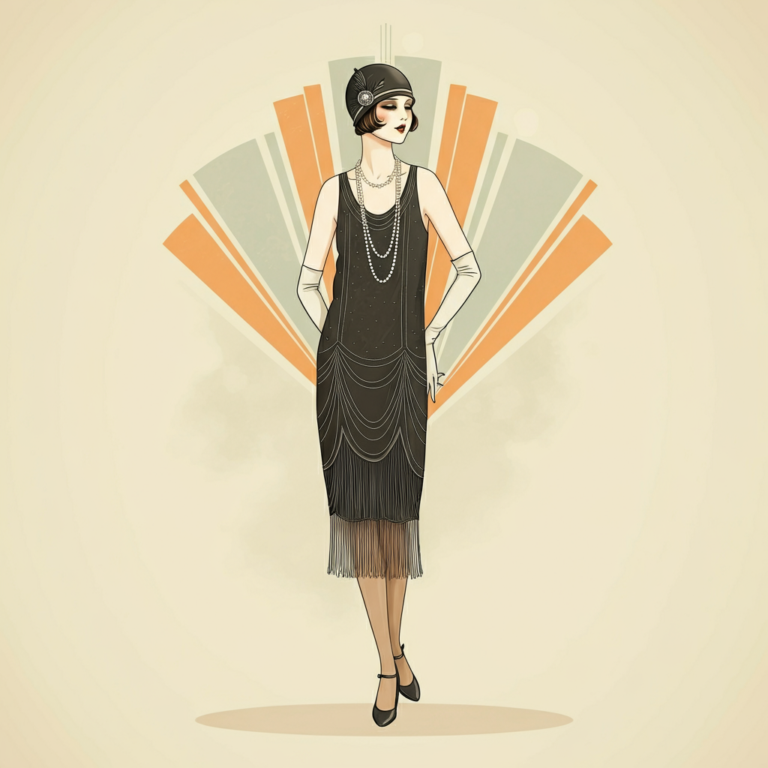The 1920s were a decade of liberation, change, and modernity for women, epitomized through dramatic shifts in Fashion. From the iconic flapper dresses to bold Art Deco patterns, this period broke away from the constraints of the Victorian era, embracing comfort, individuality, and self-expression. If you’ve ever wanted to explore this fascinating era of style, you’re in the right place.
This guide takes a comprehensive look at 1920s fashion trends for women, unearthing not only the trends themselves but also the cultural and social significance behind them. We’ll cover everything from the rise of hemlines to the popularity of cloche hats and even how accessories were used to complete this unmistakable aesthetic.
Table of Contents
Introduction to 1920s Fashion
The roaring ’20s brought about a seismic cultural shift, and women’s Fashion was no exception. It symbolized freedom, reflecting women’s newfound political rights, entry into the workforce, and a growing rejection of traditional norms. This era introduced bold, casual styles with an emphasis on ease of movement and youthfulness, setting the foundation of modern Fashion. Clothing became more versatile and daring, reflecting the lively spirit of the Jazz Age.
Key Styles That Defined the Decade
Flapper Dresses
The flapper dress became the unmistakable hallmark of 1920s Fashion. These dresses embodied the carefree attitude of the time with their loose and straight silhouettes, dropped waistlines, and knee-length hemlines (a shocking departure from past decades of floor-skimming skirts).
What made them truly striking were the intricate embellishments. Fringe, beads, and sequins caught the light during dances like the Charleston, adding a touch of glamour. Materials like silk and chiffon were favoured for their ability to flow effortlessly with movement.
Bobbed Hair
Short and chic, bobbed hairstyles revolutionized women’s views on personal grooming. Often styled sleek or with finger waves, bobbed hair symbolized not only rebellion against traditional femininity but also practicality. It paired effortlessly with the decade’s loose and geometric Fashion, making it the hairstyle of choice for millions.
Cloche Hats
Designed to complement bobbed hairstyles perfectly, Cloche hats were close-fitting, bell-shaped creations made from felt, straw, or velvet. These hats framed the face beautifully and were often adorned with ribbons, bows, or vibrant floral appliqués.
Art Deco Influences
Fashion in the 1920s embraced the Art Deco design movement, which introduced geometric patterns, metallic fabrics, and bold contrasts to the forefront. This translated to vibrant colours, luxurious embellishments, and structured statement pieces in both clothing and accessories.
The Rise of Hemlines
One of the most defining features of 1920s women’s Fashion was the dramatic shortening of skirts. Once considered scandalous, hemlines rose to just below the knee by the mid-1920s, reflecting a shift in societal norms. This change offered freedom and ease of motion, solidifying the modern woman’s desire for liberation.
Loose and Straight Silhouettes
Gone were the days of rigid Victorian corsets. Dresses in the 1920s were designed with loose, straight, tubular shapes. These silhouettes de-emphasized the waistline, providing the wearer with ultimate comfort and functionality.
Undergarments played a huge role in aiding this shift. Bralettes replaced corsets, creating a flatter and more boyish figure, which was highly desirable during this era.
The Rise of Sportswear
Casual sportswear became part of everyday Fashion. Sweaters, knits, and loose separates made their debut, offering unparalleled comfort and aligning with women’s increasingly active lifestyles. Tennis-inspired pleated skirts and casual two-piece ensembles allowed women to move as freely as their ambitions demanded.
Accessories of the Decade
Accessories were essential to completing the 1920s look. Here’s a breakdown of what reigned supreme:
- Long Pearl Necklaces
Long strands of pearls were a flapper favourite. Effortlessly elegant, they added charm and sophistication to even the simplest dresses.
- Beaded Headbands
Perfectly styled to emphasize bobbed hair, headbands were often embellished with jewels or feathers for evening soirées.
- Fringed Shawls
Often layered over dresses, these dramatic shawls added movement and texture to any outfit.
- Art Deco-Inspired Jewelry
Button earrings, stacked bangles, and intricate necklaces featured geometric designs in bold colours, capturing the Art Deco aesthetic.
Footwear in the 1920s
Footwear experienced its revolution, blending function with flair. Styles like Mary Janes and T-strap heels with curved French heels became ubiquitous. They looked playful and feminine and were practical enough to support the decade’s obsession with dancing.
The Social and Cultural Shift Reflected in Fashion
The fashion trends of the 1920s symbolized much more than aesthetics; they reflected a rapidly evolving society. Women entered the workforce, earned the right to vote, and immersed themselves in new cultural experiences, such as jazz and cinema. This newfound freedom and independence were mirrored in the relaxed and daring styles they embraced.
Hollywood also played a pivotal role in shaping fashion trends. Stars like Clara Bow and Louise Brooks became style icons, with women worldwide eagerly emulating their glamorous looks.
FAQs About 1920s Fashion Trends for Women
1. What characterized the flapper look?
The flapper look featured loose silhouettes, dropped waistlines, knee-length hems, beaded embellishments, and practical, short hairstyles, such as bobs. It represented independence and rebellion against traditional norms.
2. Why was the Bob haircut so popular?
The Bob haircut symbolized modernity, rebellion, and practicality. It was easy to maintain, perfectly complemented cloche hats and signalled a shift toward simpler, more functional beauty standards.
3. Were corsets still worn in the 1920s?
Corsets were abandoned mainly in favour of bralettes and more relaxed undergarments. These changes supported the straight, boyish silhouette that defined the decade’s fashion.
4. How did Art Deco influence 1920s Fashion?
Art Deco introduced geometric patterns, bold colours, metallic accents, and luxurious materials into clothing and accessories, thereby enhancing the decade’s modern and glamorous aesthetic.
Step Into the Jazz Age
The 1920s were more than an era of fringe and feathers. It was an era when women embraced freedom, individuality, and modernity, with fashion serving as a powerful tool for self-expression. Whether it was the relaxed silhouettes, vibrant Art Deco patterns, or playful accessories, every element told a story of breaking free.
Are you curious to learn about how these iconic trends influence today’s Fashion? Stay tuned for our next post, which will explore modern-day flapper-inspired styles!


